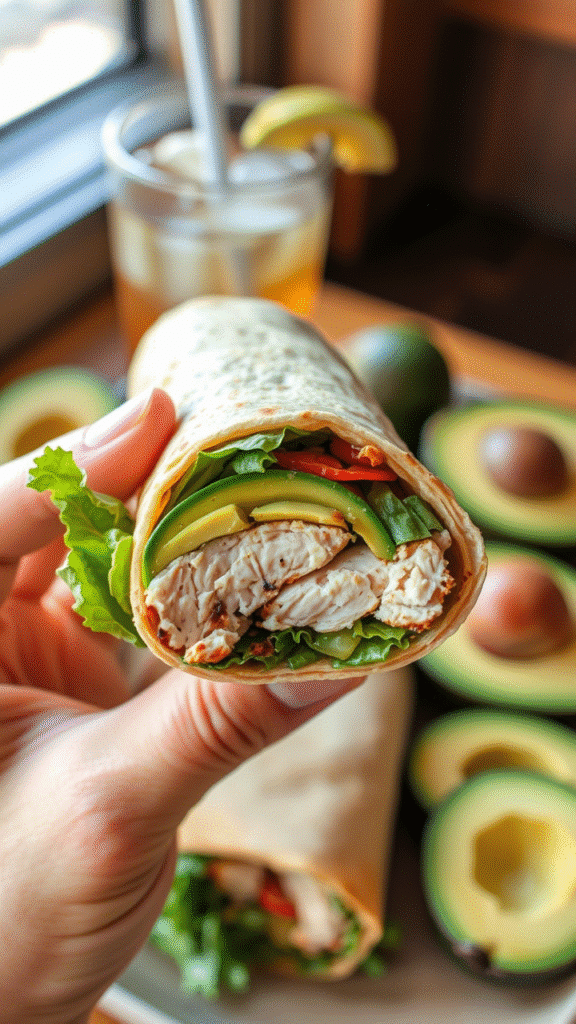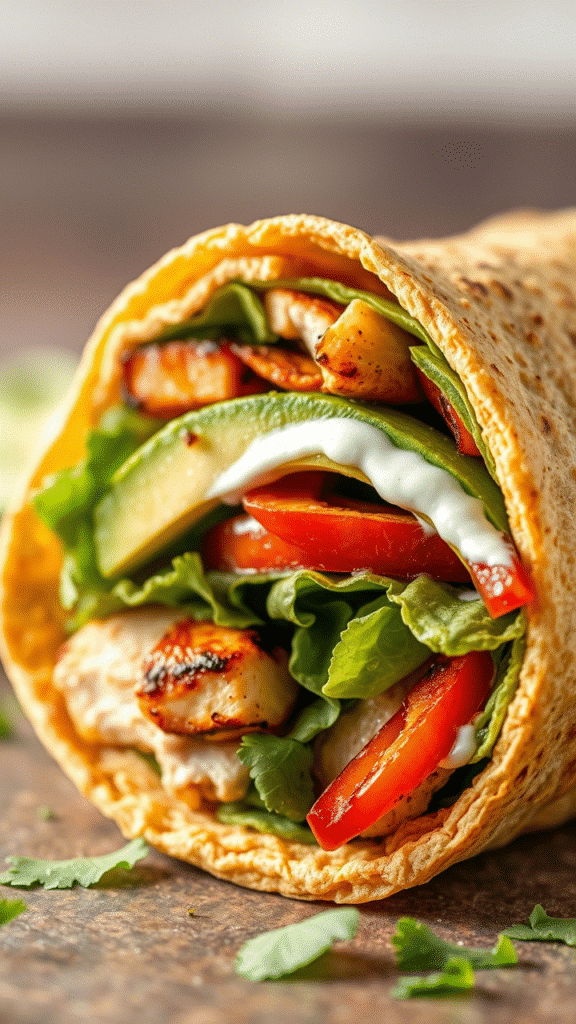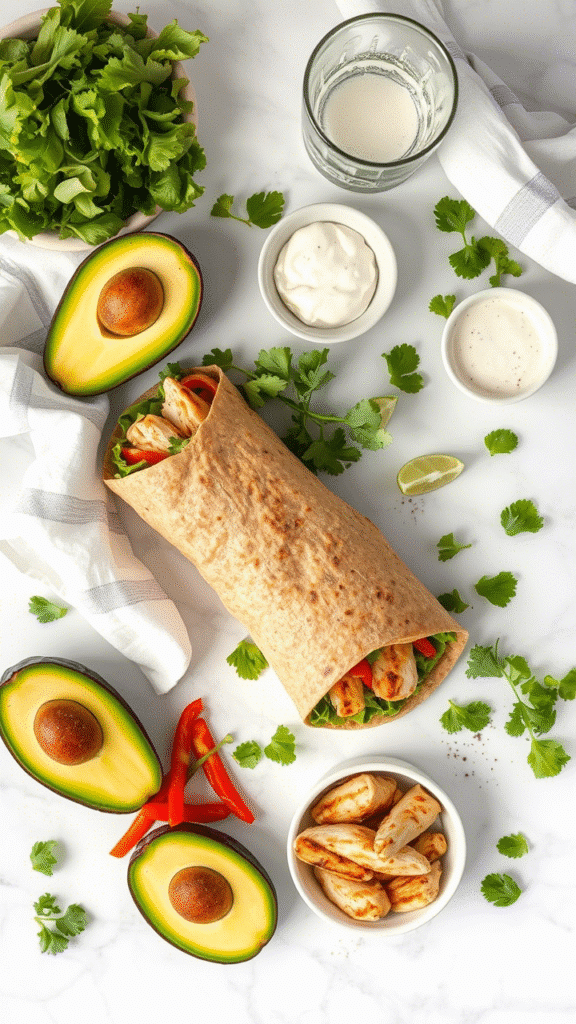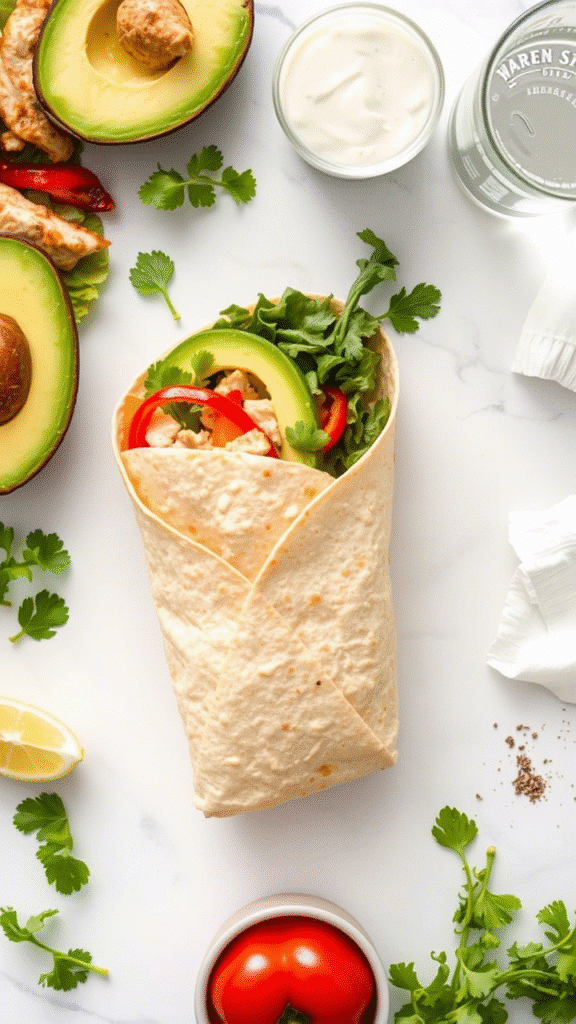Last Tuesday, I watched a line cook at my restaurant’s prep station fumble through what should have been the simplest task—assembling a chicken avocado wrap for staff meal. The tortilla tore. The filling spilled everywhere. The avocado turned brown before he’d even finished rolling it.
That moment reminded me why I’ve spent fifteen years perfecting what many consider “just a wrap.” Because here’s the thing—there’s no such thing as “just” anything in professional cooking.
The chicken avocado wrap represents everything beautiful about modern quick-service cuisine: fresh ingredients, balanced nutrition, and techniques that can be executed flawlessly under pressure. When done right, it’s a symphony of textures and flavors wrapped in portable perfection. When done wrong? Well, you get Tuesday’s disaster.
This isn’t your average lunch counter wrap. We’re talking about a carefully orchestrated combination of properly seasoned protein, perfectly ripe avocado, and supporting players that each contribute their own voice to the final composition. The technique matters. The timing matters. Hell, even the way you hold your knife when slicing that avocado matters.
Understanding Your Foundation: Ingredients & Substitutions
The Protein: Chicken Selection and Alternatives
Start with boneless, skinless chicken thighs—not breasts. I know, I know, everyone reaches for the breast meat thinking it’s “healthier,” but thigh meat has the fat content and flavor density that makes this wrap sing. The extra marbling keeps the meat moist during quick cooking methods, and frankly, life’s too short for dry chicken.
For those who insist on breast meat, pound it to an even thickness first. Use a meat mallet or the flat side of a heavy knife to achieve about ¾ inch thickness throughout. This prevents the dreaded hockey puck effect that plagues so many quick-service chicken dishes.
Vegetarian? Swap for firm tofu (pressed for at least 30 minutes), tempeh, or even well-seasoned portobello mushrooms. The key is choosing proteins that can handle aggressive seasoning and won’t fall apart during the cooking process.
The Star: Avocado Selection and Handling
Here’s where most people mess up: they don’t understand avocado ripeness. You want fruit that yields slightly to gentle pressure but isn’t soft enough to mash with a fork. The skin should be dark but not black, and when you flick the little stem end, it should come off easily without revealing brown underneath.
Buy your avocados 2-3 days before you plan to use them if they’re still hard. Store them at room temperature until they reach that perfect stage, then refrigerate to slow further ripening. This gives you a window of about 48 hours to work with optimal fruit.
Never, and I mean never, cut your avocados more than 15 minutes before service. The enzyme browning that occurs once the flesh hits air isn’t just unsightly—it also develops bitter compounds that’ll throw off your flavor profile.
Supporting Cast: The Flavor Builders
Fresh lime juice isn’t optional—it’s insurance. Beyond preventing browning, citric acid brightens the entire flavor profile and provides the acidic counterpoint that balances the rich avocado and seasoned chicken.
For greens, skip the iceberg lettuce. Use butter lettuce, baby spinach, or arugula. Each brings its own personality: butter lettuce adds crisp sweetness, spinach contributes iron-rich earthiness, and arugula delivers a peppery bite that cuts through richness.
Red onion should be sliced paper-thin and soaked in ice water for 10 minutes to mellow its bite. This technique, borrowed from traditional Mexican cuisine, removes the harsh sulfur compounds while maintaining the onion’s structural integrity and subtle heat.
Mastering the Method: Step-by-Step Construction

Chicken Preparation and Cooking
Season your chicken aggressively—at least 20 minutes before cooking, but preferably an hour. Use kosher salt, freshly cracked black pepper, ground cumin, smoked paprika, and garlic powder. The salt needs time to penetrate the meat fibers and begin breaking down proteins for maximum tenderness.
Heat your pan until it’s smoking before adding oil. This is crucial. The Maillard reaction—that beautiful browning that develops complex flavors—only occurs at high temperatures. Add a high smoke point oil like grapeseed or avocado oil, then immediately lay in your seasoned chicken.
Don’t move it. This is where discipline separates professionals from home cooks. Let that chicken sit for 3-4 minutes, developing a proper crust before flipping. You’ll know it’s ready when the edges start to look opaque and the meat releases easily from the pan surface.
After flipping, reduce heat to medium and cook until internal temperature reaches 165°F. For thigh meat, this usually takes another 4-5 minutes. Let the meat rest for at least 5 minutes before slicing—this allows juices to redistribute throughout the muscle fibers.
The Assembly Line: Wrap Construction
Warm your tortillas. Cold tortillas crack, period. Use a dry skillet over medium heat for 30 seconds per side, or wrap them in damp paper towels and microwave for 20 seconds. The slight moisture and heat makes the tortilla pliable and adds that fresh-from-the-comal flavor.
Layout is everything. Place your tortilla on a clean work surface and imagine it divided into thirds horizontally. Your filling goes in the bottom third, leaving the top third completely clear for rolling.
Start with greens as your base layer—they create a moisture barrier between the tortilla and wetter ingredients. Follow with sliced chicken, then avocado, then your accent ingredients like onion and any additional vegetables.
Rolling Technique: The Professional Approach
Here’s the technique they don’t teach in culinary school but should: the envelope fold. After placing your filling in the bottom third, fold the sides of the tortilla in about an inch on each side. This creates walls that prevent filling from escaping during the rolling process.
Starting from the filled end, roll tightly but not aggressively. Use steady, even pressure and tuck the filling as you go. The key is maintaining consistent pressure throughout the roll—too loose and it falls apart, too tight and you’ll tear the tortilla.
The final step that separates amateurs from professionals: the toothpick placement. If serving immediately, secure the wrap with toothpicks placed at 1/3 intervals along the seam. If holding for service, wrap tightly in parchment paper or aluminum foil.
The Science Behind the Perfect Wrap

Texture Dynamics and Mouthfeel
The magic of a great chicken avocado wrap lies in textural contrast. The tender, juicy chicken provides umami-rich protein. Creamy avocado adds richness and healthy fats. Crisp vegetables contribute freshness and structural interest.
But it’s the interplay between these textures that creates satisfaction. When you bite through the soft tortilla into varying textures—from the slight resistance of properly cooked chicken to the yielding creaminess of ripe avocado—your brain registers complexity and satisfaction.
Temperature contrast matters too. Room temperature avocado against warm chicken creates a dynamic eating experience that keeps each bite interesting. This is why timing your assembly is so critical.
Flavor Balance and Enhancement
Professional flavor building relies on hitting multiple taste receptors simultaneously. The chicken provides umami and saltiness. Avocado contributes richness and subtle nuttiness. Lime juice adds brightness and acidity. Properly prepared onions contribute subtle heat and aromatic compounds.
The seasoning blend I use—cumin, smoked paprika, garlic powder—creates what flavor scientists call “flavor layering.” Each spice contributes different aromatic compounds that complement rather than compete with each other.
Cumin adds earthy warmth with slight bitter notes. Smoked paprika contributes sweet smokiness without overwhelming heat. Garlic powder provides savory depth that enhances the natural chicken flavors.
Professional Presentation and Service
Plating and Visual Appeal
Even handheld food deserves thoughtful presentation. When cutting your wrap for service, use a sharp knife and cut at a slight diagonal. This exposes the colorful filling and creates visual interest on the plate.
The cut should be clean and decisive—sawing motions create ragged edges and can cause the filling to fall out. Wipe your knife between cuts to maintain clean lines.
For elevated presentation, serve on warmed plates with a small side of extra lime wedges and perhaps a simple salad dressed with lime vinaigrette. The color contrast between the wrap’s interior and the plate creates visual appeal that elevates the entire dining experience.
Holding and Storage Techniques
In professional kitchens, timing is everything. These wraps can be assembled up to 2 hours before service if properly stored. Wrap individual portions tightly in parchment paper and refrigerate. The key is preventing air exposure that causes avocado browning and tortilla drying.
For volume service, consider a component approach. Keep seasoned, cooked chicken warm in a steam table. Prepare avocado in small batches throughout service. Keep tortillas warm and pliable in a tortilla warmer or wrapped in damp towels.
Never pre-assemble more than you can serve within 2 hours. The moisture from the ingredients will eventually make the tortilla soggy, and the avocado will continue browning despite your best efforts.
Pairing and Menu Integration

Complementary Flavors
This wrap pairs beautifully with Mexican and Southwestern flavors. Consider serving alongside a light soup like pozole verde or a simple black bean soup. The earthy, complex flavors complement without overwhelming the wrap’s fresh profile.
For beverages, think bright and acidic. Fresh limeade, hibiscus agua fresca, or even a light beer like a Mexican lager work beautifully. The goal is cleansing the palate between bites rather than competing with the wrap’s flavors.
Side dishes should provide textural contrast. A simple jicama slaw with lime dressing, pickled jalapeños, or even baked sweet potato chips add interest without overwhelming the main attraction.
Seasonal Variations
Summer calls for additional fresh elements—diced tomatoes, fresh corn kernels, or even sliced peaches for an unexpected twist. The natural sweetness of summer produce complements the savory chicken and rich avocado.
Fall and winter versions might include roasted red peppers, caramelized onions, or even thin slices of roasted butternut squash. These cooked vegetables add warmth and depth that matches cooler weather cravings.
Spring variations could incorporate fresh herbs like cilantro, mint, or even basil. The bright, green flavors enhance the fresh quality that makes this wrap so appealing.
Advanced Techniques and Variations
Protein Variations
For a more complex flavor profile, try marinating your chicken in yogurt mixed with lime juice, cumin, and chipotle powder. The lactic acid in yogurt tenderizes the meat while adding tangy flavor that complements the avocado beautifully.
Grilled chicken adds smoky complexity that works particularly well in summer. If using a grill, cook over medium-high heat and resist the urge to move the chicken too frequently. Good grill marks aren’t just visual—they represent proper Maillard reaction development.
For seafood lovers, substitute grilled shrimp or even flaked salmon. Both work well with the avocado and lime combination, though they require different cooking approaches to avoid overcooking.
Tortilla Alternatives
Flour tortillas are traditional, but don’t overlook alternatives. Whole wheat tortillas add nutty complexity and extra fiber. Spinach or tomato tortillas contribute color and subtle flavor variations.
For lower-carb options, large lettuce leaves like butter lettuce or iceberg can serve as wraps. The key is choosing leaves large enough to contain the filling while providing enough structure for handheld eating.
Lavash bread or large naan can also work, though they create a different eating experience with more substantial bread flavors that complement rather than compete with the filling.
Troubleshooting Common Problems

Preventing Soggy Wraps
Moisture control is critical. Always pat your chicken dry after cooking and before slicing. Use a paper towel to remove excess moisture from washed greens. If using tomatoes or other high-moisture vegetables, salt them lightly and let drain for 10 minutes before using.
Consider the order of assembly. Place moisture-sensitive ingredients like lettuce between the tortilla and wetter ingredients. This creates a barrier that prevents sogginess while maintaining structural integrity.
Avoiding Flavor Imbalance
Taste as you go. Season your chicken properly, but also taste your assembled ingredients before final rolling. Sometimes you need an extra squeeze of lime or pinch of salt to bring everything into balance.
Remember that flavors meld over time. What tastes properly seasoned immediately after assembly might taste under-seasoned after 30 minutes of storage. Slightly over-season initially to account for this mellowing effect.
Final Thoughts: Elevating the Everyday
The chicken avocado wrap might seem simple, but mastering it requires understanding ingredient selection, proper technique, and timing. It’s a perfect example of how professional standards can elevate even the most casual dishes.
Remember that consistency is what separates professional food from home cooking. Every wrap should look and taste the same, regardless of who’s making it or what time of day it’s prepared. This requires standardized procedures, quality ingredients, and attention to detail.
Don’t underestimate the power of a well-executed simple dish. In a world of molecular gastronomy and Instagram-worthy presentations, sometimes the most impressive thing you can do is make a perfect chicken avocado wrap that exceeds every expectation.
Master these techniques, understand the why behind each step, and you’ll never look at “just a wrap” the same way again.
Frequently Asked Questions?
Q: How far in advance can I prepare chicken avocado wraps for meal prep?
A: While the chicken can be cooked up to 3 days ahead and stored refrigerated, complete wraps should only be assembled 2-4 hours before eating. The avocado will brown despite lime juice treatment, and tortillas become soggy from ingredient moisture. For best results, prep components separately and assemble fresh.
Q: What’s the best way to prevent avocado from browning in prepared wraps?
A: Use fresh lime juice immediately after cutting avocado, ensuring all exposed surfaces are coated. Wrap completed wraps tightly in parchment paper to minimize air exposure. However, even with these precautions, expect some browning after 2-3 hours. For longer storage, consider using avocado oil or a commercial browning inhibitor.
Q: Can I make these wraps healthier without sacrificing flavor?
A: Absolutely. Use whole wheat or high-fiber tortillas, increase the vegetable content with bell peppers or cucumbers, and consider Greek yogurt-based sauces instead of mayo-based ones. You can also reduce the chicken portion slightly and add black beans for fiber and plant protein. The key is maintaining the textural and flavor balance that makes the wrap satisfying.
Q: My tortillas always crack when I roll them. What am I doing wrong?
A: Cold, dry tortillas are usually the culprit. Always warm tortillas before assembly—either in a dry skillet for 30 seconds per side or wrapped in damp paper towels in the microwave for 15-20 seconds. Also check your filling placement; overfilling or placing ingredients too close to the edges makes rolling difficult and increases tearing risk.
Q: How do I scale this recipe for large group catering?
A: For volume production, use an assembly line approach. Pre-cook chicken in batches and hold warm. Prepare avocado in smaller batches throughout service to maintain freshness. Set up stations with warmed tortillas, pre-portioned ingredients, and multiple staff members handling different components. Plan on 15-20 wraps per person per hour with an experienced team.

Veronica is a passionate food enthusiast with over three years of experience in exploring and writing about diverse cuisines. Her expertise lies in reviewing restaurants, sharing creative recipes, and discovering the latest food trends. As the voice behind FoodieRecap.com, Anju brings fresh perspectives and culinary insights to her audience.
